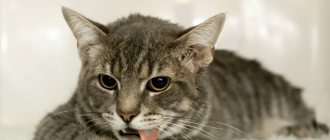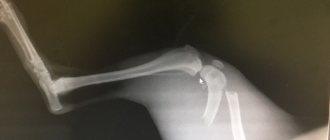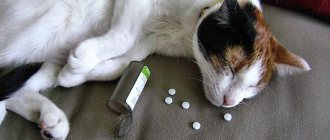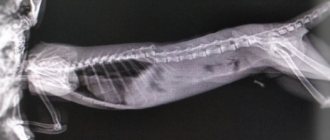About 15% of cat injuries occur due to falls from a height.
More often this trouble happens to them at night. It turns out that the safest floors for cats to fall from in residential buildings are the fifth to ninth floors. When falling from low floors, the animal does not have time to group itself correctly, and when falling from a higher height, grouping will not help. Even a fall from the kitchen table can be traumatic for small kittens, since control of their body comes to them in full with age. If a cat falls into obstruction in the form of clotheslines or tree branches, the injuries may be more serious than from a simple fall.
If a cat falls, it can suffer varying degrees of injury. It may be limited to ordinary fright, but it can also break its legs, get a head or spine injury, or severe bruise of internal organs. If the cat is not very old and seeks veterinary help after an injury, almost any injury can be treated. Measures must be taken to prevent accidental falls of the animal. It is better to keep the windows closed, or be sure to install a net.
If a fall could not be avoided, first aid must be provided. A frightened animal may simply hide somewhere to lie down in a secluded place. We definitely need to find it and inspect it. In such a situation, the cat can behave very aggressively, so gloves will not hurt you to protect yourself from claws and teeth.
Cats are very patient and hardy. It is very difficult to determine by appearance whether an animal is in pain or not after a fall. It happens that after a fall, a cat quickly jumps up and runs away without external signs of damage. Although some time after this misfortune she may die from internal bleeding. Therefore, after any serious fall, you should definitely contact a veterinarian for help. If after a fall the cat continues to lie at the site of the fall, then you need to act very quickly and carefully. The best option is to carefully place the victim on a hard surface, such as a sheet of plywood, and take her to the nearest hospital.
Most often, animals that fall from a height die not from their injuries, but from shock!
How do cats fall?
Most cats know how to regroup in flight so that they fall on their paws. But not all cats have this ability: for example, ragdolls do not know how to regroup, so for them even a fall from a wardrobe can be fatal. For others, regrouping is not a guarantee of survival.
Article continues after advertisement
If you compare cats and people, the difference is also in weight. After all, cats are lighter, so the impact force also decreases.
In addition, cats have an internal “device” that allows them to orient themselves in flight and rotate 180 degrees. First, the cat, turning around its axis with its paws down, stretches them out and arches its back. In this case, cats can spread out in the air like flying squirrels, like parachutists, thereby slowing down their flight speed. The tail, which is intended for this purpose, also allows maneuvering.
Once the cat has turned its paws down and assumed a position comfortable for falling, it prepares to meet the ground. First, the paws come into contact with it, as the least valuable parts of the body, then the cat’s movement towards the ground may end - then no more parts of the body will take the blow. But it happens that the shock-absorbing capacity of the paws is not enough, then the cat also hits the ground with its muzzle. Next, the torso suffers. Whether this is so or whether the cat lands on its paws and runs calmly for longer depends on many factors: its initial state, the surface under the windows, obstacles encountered during the flight and, of course, it depends on the height of the fall.
What diagnostic methods are needed in a clinical setting?
At the veterinary clinic, the doctor will examine the animal and carry out diagnostic measures:
- clinical and biochemical blood tests;
- X-ray of the chest, which will exclude rib fractures, lung contusion, pneumo- and hemothorax;
- photographs of the skull, spine, pelvic bones, limbs if fractures are suspected;
- Ultrasound is indispensable in assessing the condition of internal organs (liver, spleen, kidneys, bladder).
Based on the results of the studies, the doctor will decide on the need for emergency surgery and will put on a drip - this will relieve stress, intoxication, pain, and compensate for blood loss. Surgical treatment of fractures is carried out after stabilization of the condition - on days 3-4.
Which floors are more dangerous to fall from?
Traditionally, the most dangerous floors for a cat to fall are considered to be from the 3rd to the 5th. The fact is that this is such a height that is already dangerous, but at the same time insufficient for the cat to have time to regroup in flight and fall on its paws.
Floors 5 to 9 are considered the safest, because... at such a height, the cat already has time to regroup, but its shock-absorbing capabilities are still enough to withstand injuries from a fall.
But in general the pattern is this: the higher the floor, the more dangerous it is. But there are cats who have successfully fallen from the 11th floor, getting off with only a slight fright.
What are the symptoms of serious injury after a fall?
A visual inspection will tell you what injuries the cat received when it fell:
- if she lies motionless, most likely she has a spinal fracture;
- failure of the hind legs indicates damage to the pelvic bones;
- curvature of the limbs and lameness will indicate dislocations or fractures;
- vomiting and disorientation may suggest a concussion;
- heavy breathing will reveal a lung bruise;
- drooling and an open mouth are signs of a jaw fracture;
- an enlarged, painful abdomen combined with bleeding from the nose, mouth or anus indicates serious injury to internal organs;
- shallow breathing, pale mucous membranes, weak pulse suggest traumatic shock;
- blood in the urine will indicate a kidney injury.
If no visible damage is found, do not rush to relax. Alarming symptoms may appear later. Among them:
- drowsiness;
- aggression;
- decreased appetite;
- spitting out food;
- increased salivation;
- breathing problems due to diaphragmatic hernia;
- unsteady gait;
- reluctance to step on paws;
- forced poses;
- lack of urination (more than a day) and defecation (more than two days).
Once I saw a neighbor's cat fall from a 5th floor window. She landed, was in a stupor for several seconds, and then flew away in an unknown direction. This behavior does not at all mean that the animal remained safe and sound. The release of adrenaline into the blood from the resulting stress could temporarily dull the pain, and serious consequences would appear a little later. Unfortunately, nothing is known about the further fate of this cat.
If a cat falls, it can suffer internal injuries that are invisible to the eye, so in any case it is important to show it to a qualified veterinarian.
Fall Prevention
Mosquito nets do not help keep a cat out of a window. They are absolutely useless and only protect against mosquitoes. These nets do not stick well to the window and are easily torn. If the cat needs it, it will jump out in no time.
Don’t rely on plastic windows with ventilation mode. This doesn't save cats. They often get stuck between the frames, receiving damage no less terrible than if they fell.
Article continues after advertisement
Instead of all this, special metal meshes were invented for cats. They are attached to the window very securely and do not tear. Cats can even jump and hang on them. Therefore, if you have a tailed friend living at home, such a net is vital.
Diagnostics
Neither successful treatment nor a reasonable prognosis for the affected cat is possible without an accurately established diagnosis.
Clinical examination
On the examination table, the doctor examines and carefully palpates the injured animal. Particular attention is paid to the preservation or absence of motor reflexes and pain sensitivity. Already at this stage, it is possible to approximately assess the location and extent of damage to the spinal cord.
Severe fractures of the spine are visible to the naked eye (back deformation, unnatural body position), but the doctor always sends a cat suspected of such a diagnosis for an x-ray examination.
X-ray
The good thing about X-rays is that the images can be taken without anesthesia and quickly provide additional information about the injury. Digital X-rays are not available everywhere, but not a single decent veterinary clinic can do without a conventional device.
The images will show tumors, fractures and vertebral displacements. In case of severe injuries, based on X-rays, it can be confirmed that the spinal cord is ruptured (a combination of fracture and dislocation of the spine). However, the nerve substance itself cannot be seen on an x-ray. Therefore, if the owners are ready for surgery and want to do everything possible, the cat will have to undergo a special diagnosis.
Contrast myelography
To make the spinal canal visible on x-rays and determine the location of its compression, a contrast agent is injected between the membranes of the spinal cord. The pet must be under anesthesia. After contrast is administered, a series of x-rays are taken at regular intervals.
The advantage of such research is its wide availability (no special equipment is required) and information content. However, compared to CT or MRI, myelography is more dangerous because it is an invasive diagnostic method. In 1-2 animals out of 100, it causes complications associated with increased intracranial pressure or accidental damage to a vessel with a needle and the formation of a hematoma.
Magnetic resonance imaging (MRI)
The gold standard for diagnosis for any spinal injuries is MRI, as it makes it possible to see in detail the nervous tissue of the spinal cord, the area and degree of damage, and compression. This study is performed under general anesthesia. An MRI should precede all spinal surgery (and helps determine whether such surgery is advisable at all).
Consequences of a fall
The consequences of a fall can only be stress and bruises, but there can also be fractures and internal bleeding or instant death. It depends on your luck. If a cat falls on the grass or in a snowdrift, it has a better chance of surviving. If on asphalt, prepare for the worst.
Elena: “We didn’t have a metal mesh before, or even a mosquito net. The cat was not allowed on the balcony, but she still made her way there from time to time. I really loved walking on metal clothesline holders. But everything always ended well. And then they overlooked it: and the cat fell from the 3rd floor. We didn't notice her absence for a couple of hours, because... she always loved to hide and sleep somewhere. But after 2 hours they became worried: the cat was nowhere to be found. Then the thought arose that she had fallen. I went under the windows to look. Screamed her name. And then I hear the cat’s “Meow!” I look, and my six-month-old baby is sitting in the basement window and calling me. As soon as I went to her, she rushed towards me and grabbed me with her paws, releasing her claws, as if she was afraid that I would let her go. She waited for me for 2 hours! Afterwards, at home, she peed blood several times. But after that everything returned to normal. The cat lived for 18 years and died of old age. We were very lucky that she was strong and resilient! What’s most interesting is that after that we moved to the 6th floor, under supervision the cat was allowed to sit on the bedside table near the open window - she never tried to jump down, because that lesson was enough for her for the rest of her life.”
The editors of the MURKOTIKI website would like to point out that this is just an isolated example. Many cats do not learn from their mistakes and after a fall, no matter how serious, may not be afraid of heights and fall again. So it’s worth taking preventative measures in any case.
Fall from Height Syndrome in Cats
Good afternoon Such a disaster happened, my cat Masik (neutered) fell from the 12th floor on July 8, 2017 at about 10 a.m., due to the negligence of a neighbor who opened the window. 12 years ago I took him from the street. A neighbor from the next door discovered him in the lilac bushes, he meowed pitifully, did not stand up on his hind legs, they immediately took him to the vet. clinic, they gave me an anti-shock, hemostatic, analgesic, diuretic and injected me with diphenhydramine, took an x-ray, they said there were no fractures of the bones or spine, but possible displacement of the pelvis, sacrum and 6.7 spine. In the evening at about 19.00 he felt bad, Masik peed, the urine was dark orange, he turned blue all over and began to choke, stuck out his tongue, which stuck to the roof of his mouth and was purple, then his breathing stopped, I took his muzzle and began to perform artificial respiration, he opened it slightly my eyes and began to breathe, I opened the window so that there was more air, wet a cotton swab with alcohol and held it near my nose at a distance of 10 cm. All in tears, I took it in my arms and went to the 24-hour State Hospital. veterinarian at the clinic, ran in shouting “Help, he’s dying.” The doctor came out, they immediately took him in for an ultrasound, they said he had a bruised lung, kidneys, and there was a moderate amount of free fluid in the abdominal cavity, his bladder was weakly full, then he was transferred to another room and put on an oxygen mask. So I stayed with him until 5 in the morning, his body temperature was 34, they covered him with heating pads and gave him 6 injections. by morning the temperature was 36.2. We were sent home and told to come to the traumatologist in the morning. His breathing stabilized a little. At 11.00 we went to see the traumatologist. After looking at the picture, he said that the right lower rib might be broken, the pelvis and spine might be displaced (another suspicion is that the right process at the bottom of the vertebra is broken, right under the vertebra, but perhaps the picture is of poor quality) and a pinched nerve .Surgery may be required, but for now we will try to remove the tumor. The tail and both hind legs are sensitive. We were injected with Prednisolone, Analgin and Milgamma, a course of 10 days in addition to other injections. Then Masik began to foam thickly at the mouth. The doctor said this was a reaction to Analgin and not to inject it, after half an hour it went away. In the evening we went to a veterinary clinic near our house for procedures. We came home and tried to feed her through a syringe and give her something to drink. An hour later, he started vomiting, he peed on himself, but the urine was already yellow, the attacks of vomiting were then empty, and repeated at intervals of 2 hours. I took him in the morning and brought him to the vet, she said that dehydration was possible, his skin did not tighten as usual, and if you pull, it stands on end and does not spread. He was put on a drip, 3.5 hours in the morning and 3.5 hours in the evening for 3 days (during these days he was in a day hospital). During these days they fed and watered them by force. The temperature rose to normal each time. I myself haven’t eaten for days with him, I was worried, well, how can you leave your little blood, he looks with pitiful eyes and asks for help, after all, we’ve been living together in perfect harmony for 12 years, I’ve always been on proper nutrition, I cooked porridge with fish. And then at night I took a nap for about 10 minutes, I woke up with him not at the head of the bed, and he climbed onto my sore stomach and buried his face in it, and so they treated each other... he was using his last strength... They gave him to chemo. analysis, liver and kidney levels are very elevated. They began to reduce the dosage of the drips, then an interest in water appeared, and I drank it myself at home. I poured Vaseline oil through a syringe. Ursofalk 1.10 was prescribed for the liver at night. The next day, I started eating on my own. I give him chicken soup, a raw egg, and Royal liquid food for neutered cats. He started asking to go to the toilet, dragging his hind legs, but trying to push off. The temperature now stays at 38.8-39. 15.07. He began to purr excitedly, as if he was thanking him, and did not stop for 3 hours)))) The painkiller was stopped. 17.07. I started licking myself and went big))) 18.07. I took him to the traumatologist, and you know... he put him on the table... and he stood on his hind legs and sniffed the table. He said that he needed to develop his paws and place them so that he could walk more, and do a massage, I did this, the right paw is intertwined with the left... Prednisolone was reduced by 0.1, injected for another 5 days, Milgamma was canceled, Akgoverin was prescribed for 10 days. For the last two days I’ve been taking him out onto the grass, he runs headlong with his front paws, I put his hind paws on him, he falls to the right, his pelvis doesn’t seem to hold up if you put your legs wider, he stands for about 2 minutes, he pees on the street and can poop on his own standing, without support. But if you go, you fall, but try to get up. Every day there are small victories... and joys... I have a question, with proper care and with such indicators, my baby will get back on his feet, today they scared me that a friend’s cat fell from the 5th floor, but in my opinion they didn’t take him to the vet clinic, paws dragged his hind legs, and a month later he died, while others had internal bleeding and he left this world 10 days later? And what is responsible for the appendage on the lower right side of the spine that may have been broken off? and if now the condition is stable for 5 days, could there be a critical deterioration? Thank you in advance for your answer.
What to do if your cat falls
What to do if such a misfortune happens to your furry friend? Remember the main rule: if after a fall the cat lies motionless, you cannot simply lift it from the ground. To move the animal, use a board or thick cardboard as a stretcher. Carefully, trying not to change the position of the pet, move it onto the stretcher, fixing its head.
It is best for an injured cat to lie on its side. If the animal vomits, you need to support its head to avoid vomit getting into the respiratory tract.
If your pet shows signs of internal bleeding, try positioning him so that he does not move. You can apply a cold compress or ice wrapped in something to your stomach or head.
Tags
Cats and cats get injured in a fall, a cat gets caught in a fall, a cat can If a cat is not in a situation, a cat can Cats are very that a cat after a fall, the cat continues to help the cat or internal bleeding.
floors very answer feed the dogs just became the author of the houses themselves told us the toilet lets know got a loot then now a little paws nothing paws a month to walk found today drinks before the back










